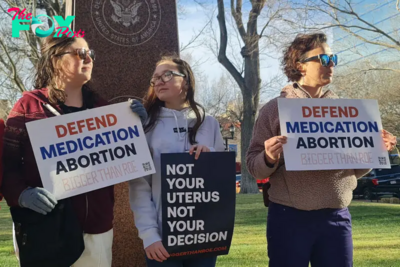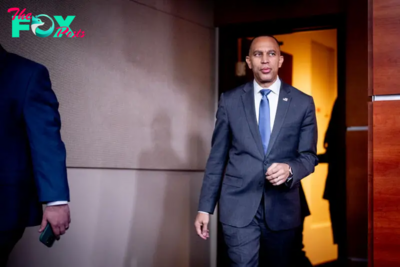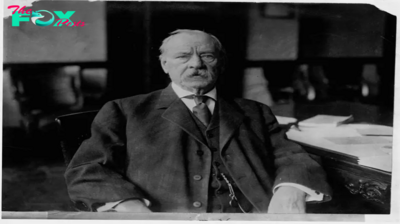Politics
Lebanese-Israeli fighting looks set to scuttle plans for historic land border settlement
In October 2022, Lebanon and Israel signed a maritime border agreement brokered by the U.S., a move interpreted as the beginning of normalizing relations between two countries technically at war.
The next step would have been the settlement of the long-running land border dispute.
But then came the Hamas attack of Oct. 7, 2023, and Israel’s response in bombing Gaza. The following day, Hassan Nasrallah, secretary general of Lebanon’s political party and militant group Hezbollah, announced the faction had “entered the battle,” effectively dragging Lebanon into fresh, intensified fighting with Israel.
Since then, near-daily tit-for-tat strikes have seen Hezbollah fighters fire missiles into northern Israel and Israel Defense Forces responding in kind.
As a scholar who researches evolving issues in Lebanon and the Middle East, I worry that as regional violence escalates, the long simmering conflict between Israel and Lebanon is heading toward an unavoidable full-blown war. In such circumstances, hopes for a land settlement to accompany the historic maritime deal look, for now at least, dead in the water.
Lebanese–Israeli relations
For over 75 years, Israel’s border with Lebanon has been a source of conflict. Following the proclamation of the state of Israel in 1948, hundreds of thousands of Palestinians were expelled or fled their land; many ended up as refugees in Lebanon, Syria and Jordan.
In 1964, the Palestine Liberation Organization was created and began to operate cells and recruit members from the Palestinian refugee camps in those three countries. In 1970, the PLO was expelled from Jordan.
It moved its headquarters into Lebanon, and by the mid-1970s over 20,000 PLO fighters were in Lebanon launching attacks on Israel. Their armed presence divided Lebanese public opinion between those who wanted to make peace with Israel and those who wanted to defend the Palestinian cause.
On April 13, 1975, violence erupted over the issue of Palestinian armed presence in Lebanon, and the country descended into chaos.
It resulted in a messy civil war in which Palestinian insurgents in Lebanon fought the country’s Christian population while also continuing to fire rockets into Israel. Lebanon thus became an unstable political and security threat to Israel.
In 1982, Israeli Defense Minister Ariel Sharon launched Operation Peace for Galilee. On June 6 of that year, Israel Defense Forces invaded Lebanon with the intent to eliminate PLO fighters. Nearly 18,000 people were killed and another 30,000 wounded during the invasion.
The Lebanese authorities called for help, and a multinational peacekeeping force composed of American, French, British and Italian troops arrived in August 1982. Its mission was to evacuate PLO fighters out of Lebanon into Tunisia.
But on Sept. 14, Lebanese President-elect Bashir Gemayel was assassinated. In retaliation, the Lebanese Christian Phalangist militia entered the Palestinian refugee camps of Sabra and Shatila and killed over 2,000 civilians. Evidence suggests Israel played a role in these massacres and was indirectly responsible for them.
Israel officially retreated from Beirut in September 1982, but it occupied southern Lebanon until 2000.

It was during this Israeli occupation that Hezbollah, a Shiite political party in Lebanon and militant organization backed by Iran, was born. Hezbollah and the IDF have been engaged in fierce fighting ever since, including a 1996 war known as Operation Grapes of Wrath, in which an estimated 200 were killed.
Land and maritime border disputes
Much of the fighting between Hezbollah and Israel takes place along a border that has been contested since the creation of Israel. Matters became more complicated with the occupation of the Golan Heights – a former Syrian territory that borders Israel and Lebanon and was taken by Israeli forces during the 1967 Six-Day War.
In the past, there have been attempts to settle land disputes. In 1949, Israel and Lebanon signed the general armistice agreement, which adopted the boundaries of the mandatory territories of Palestine and Lebanon. This agreement continues to exist on paper.
In May 1983, Israel and Lebanon signed an agreement calling for the establishment of peaceful diplomatic relations between the two states. However, after the assassination of Gemayel and the Sabra and Shatila massacres, the agreement was not implemented.
Following the IDF withdrawal from southern Lebanon in 2000, a “Blue Line” was established by the U.N. It is not a real border but rather an imagined line separating the two states and monitored by the United Nations Interim Force in Lebanon.
Although the Blue Line acts as a buffer zone between Lebanon and Israel, it does not offer an accurate drawing of land boundaries and does not solve the issue of a key source of contention: the disputed Shebaa Farms.
Located between Israel, Syria and southern Lebanon, the Shebaa Farms have been contested lands for over two decades. While Lebanon and Hezbollah claim that it is Lebanese territory, Israel asserts that it is part of the Golan Heights, which it continues to occupy.
After appointing cartographers, the United Nations declared the Shebaa Farms Syrian territory captured by Israel in 1967.
In 2011, Syrian leader Bashar Assad recognized that the Shebaa Farms are Syrian, refuting Hezbollah’s claim over this land and Israel’s jurisdiction in the occupied Golan Heights.
Meanwhile, efforts led by the U.S. began to look at the issue of Lebanon and Israel’s disputed maritime boundary, starting in earnest in 2010.
The discovery of the Leviathan field, the largest gas reservoir in the Mediterranean, made it urgent to address the question of the maritime borders. With gas exploitation and economic growth a possibility, it was deemed important to lower security risks for investors.
In 2022, Amos Hochstein, the American envoy for energy affairs, met separately at the Blue Line with Israeli and Lebanese officials. Hezbollah was involved in the negotiations and gave the green light for the deal to be sealed. In October of that year, the U.N. was notified of the new Israeli and Lebanese maritime borders.
It came amid other signs of a lessening in tensions between Israel and Arab states. In September 2020, the United Arab Emirates signed the Abraham Accords in which it recognized Israeli statehood. Soon after, Sudan and Bahrain followed suit.
Moving forward
The maritime border agreement carried a potential for peace in the region, a deal that would, potentially, benefit both Lebanon and Israel.
The next step would have been drawing land boundaries. In fact, Hochstein had already held preliminary discussions over 13 land border points, including the Shebaa Farms, and had explicitly said that the U.S. is ready to help mediate between the two countries.

Hamas’ terrorist attack on Oct. 7, 2023, and the ongoing Israeli war in Gaza have, however, derailed the process.
It is hard to envision a land border deal in such circumstances, especially after the January 2024 assassination of Hamas leader Saleh al-Arouri in Beirut and Hezbollah’s vow to avenge the death.
The final nail in the coffin looks to be Saudi Arabia’s statement on Feb. 7, 2024, that it can have no diplomatic relations with Israel unless an independent Palestinian state is recognized with the 1967 borders and East Jerusalem as its capital.
It has ended hopes, for now at least, that Saudi Arabia will follow the UAE’s lead and normalize diplomatic relations with Israel.
The U.S. is still desperately trying to keep the land deal alive. Recently, Hochstein visited Lebanon and met with anti-Hezbollah parties in an attempt to end hostilities between Hezbollah and Israel and move forward with a land agreement.
One voice often neglected in all this is that of the Lebanese public. Many Lebanese have expressed their opposition to war. In one recent poll, a majority agreed that what the country needed was domestic and economic reforms more than involvement in foreign policy issues. A historic land deal accompanying the maritime settlement may have gone some way to achieve those goals. Instead, the danger now is a full-scale war that will scuttle any negotiations.
-

 Politics15m ago
Politics15m agoHow the Biden Administration Protected Abortion Pill Access—and What Trump Could Do Next
-

 Politics15m ago
Politics15m agoWhy Trump’s Tariffs Could Raise Grocery Prices
-

 Politics11h ago
Politics11h agoThe First Trans Member of Congress Expected Pushback Like Mace’s Bathroom Rule
-

 Politics11h ago
Politics11h agoNew York Prosecutors Oppose Dismissing Trump’s Hush Money Conviction
-

 Politics16h ago
Politics16h agoWhite House Christmas Tree Is a Symbol of Resilience for Hurricane-Hit North Carolina Farms
-

 Politics1d ago
Politics1d agoHakeem Jeffries Wins Reelection as House Democratic Leader Despite Party’s Losses
-

 Politics1d ago
Politics1d agoHow Grover Cleveland’s Grandson Feels About Donald Trump Becoming the Second U.S. President to Serve Nonconsecutive Terms
-

 Politics1d ago
Politics1d agoAs Trump Seeks Mass Deportations, Workplace Raids May Not Help Much
















